2.0 TMC Capabilities (2002 ITS Deployment Tracking Survey)
TMCs serve as the focal point for monitoring, controlling and coordinating various functions required to manage a regional transportation system. At a TMC, information about the region's freeways, highways, traffic signals, ramp meters and transit services is collected and processed, and combined with other operational data to initiate control strategies to effect changes which improve system performance. TMCs also provide centers for communicating transportation-related information to the media and the traveling public. Key TMC activities, discussed throughout this chapter, are identified in Exhibit 1 [1].
2.1 Results from 2002 ITS Deployment Tracking Survey
To investigate the current functionality and capabilities of TMCs to support emergency transportation operations, the research team first coordinated with the FHWA's Metropolitan ITS Deployment Tracking Project to obtain available data regarding freeway management systems.
In the summer and fall of 2002, the FHWA's Metropolitan ITS Deployment Tracking Project surveyed 121 freeway management agencies located in the nation's 78 largest metropolitan areas. The survey was in three sections, and contained 95 questions. The first section covered core data needed to assess ITS technology deployment. These data have been updated with every survey since 1996 to support tracking of ITS trends and implementation. The second and third sections covered important data needed by groups or individuals in the U.S. Department of Transportation (US DOT) to help in managing the national ITS program. The areas covered represent topics that are of high current interest but may not be included in subsequent surveys. Specific questions in these sections are devoted to the establishment and staffing of TMCs, the use of incident management programs, and coordination with public safety personnel.
Since January of 2003, the FHWA's Metropolitan ITS Deployment Tracking Project has been clarifying, validating and reviewing the Freeway Management survey responses. In mid-August and early September 2003, the Project provided the research team with its most current, cleaned and validated data from the 2002 survey. This data indicates that as of September 2002, the total number of surveys returned was 119 (98 percent response rate). Not all respondents answered every question. Some questions were not applicable to a given respondent, and others may have been overlooked by some respondents. In some cases, invalid data has been screened, removed, or corrected by the Project. On average, for most questions that could have been answered by all respondents, between 105 and 115 survey responses are reported. The research team also reviewed findings, published by the Metropolitan ITS Deployment Tracking Project in February 2003, which summarize results from 447 surveys received from law enforcement agencies and 423 surveys received from fire and rescue agencies in 78 major metropolitan areas throughout the country. These results further expand upon existing relationships and information sharing activities between the transportation and public safety communities.
| Category | Type | Purpose | Activities | TMC Function(s) |
|---|---|---|---|---|
| Perform Monitoring | Delays, Hazards |
Evaluate Real Time Travel Conditions for Impediments |
|
|
| Manage Events | Random (Non-recurring Events) | Mitigate Impact of Incidents by Management |
|
|
| Manage Events | Random (Non-recurring Events) | Control Traffic Flow to Improve Safety, Reduce Travel Time |
|
|
| Manage Events | Random (Non-recurring Events) | Respond to and repair equipment failures |
|
|
| Manage Events | Recurring Events | Mitigate Delay Propagation on Highway Segments |
|
|
| Manage Events | Recurring Events | Reduce Demand on Congested Segments |
|
|
| Manage Events | Scheduled Events | Mitigate Impact of Special Event on Traffic Flow |
|
|
| Provide Services | Traveler Information | Enhance Travel by Providing Trip Information Directly to Travelers |
|
|
| Provide Services | Broadcast Media Information | Providing Trip and Event Information Directly to Media |
|
|
| Provide Services | Service Patrols | Respond to Minor Incidents Such as Vehicle Breakdown |
|
|
| Provide Services | Traffic Signal Control | Coordinate Traffic Signals to Optimize Arterial Street Traffic Flow |
|
|
| Provide Services | Traffic Signal Control | Respond to Signal Malfunction Reports/calls [d] |
|
|
| Provide Services | Public Transit | Provide Transit Information to Improve Service |
|
|
| Provide Services | Reversible Lane and HOV | Manage Reversible Lane(s) to manage capacity [e] |
|
|
| Provide Services | At-Grade Rail Crossings | Manage At-Grade Rail Crossings to improve safety |
|
|
| Provide Services | Overheight Vehicle Control [f] | Prevent Facility Damage and Accidents |
|
|
| TMC Support [g] | Human Resources Staffing | Provide staff to accomplish TMC mission |
|
|
| TMC Support [g] | Human Resources Training | Provide training to establish the needed capabilities |
|
|
| TMC Support [g] | Record Keeping and Reporting | Document Operations and Maintenance activities as required by policies |
|
|
| TMC Support [g] | System Maintenance Monitoring | Keep equipment and systems operational |
|
|
Notes:
- APTS = Advanced Public Transportation Systems, a type of Intelligent Transportation System (ITS)
- ATIS = Advanced Traveler Information Systems
- ATMS = Advanced Transportation Management Systems
- CCTV = Closed Circuit Television Cameras
- DMS = Dynamic Message Signs
- HAR = Highway Advisory Radio
- HOV = High Occupancy Vehicles
- RWIS = Roadway Weather Information Systems
- TMOT = Transportation Management Operations Technician
a. Incident Response includes a complex set of actions
b. Lane Signals = Regulatory Lane Control, or Lane Use Signals
c. Traffic Signal Timings can be adjusted to facilitate improved traffic flow on an arterial diversion route
d. Most TMCs do not receive signal malfunction calls, however there are enough important exceptions to warrant inclusion in this table.
e. Some reversible and HOV lane gates are controlled by TMC operators, but the norm is for field control of gates and visual sweeps of CCTV views prior to reversal.
f. Overheight Vehicle Control is a Service, because it is intended to prevent an incident. When an overheight accident happens, it is part of incident management.
g. These activities are central to the operation and maintenance of the TMC, but do not directly affect traffic management functions.
2.2 TMC Overview
Results from the FHWA's Metropolitan ITS Deployment Tracking Project Freeway Management Survey indicate that there are 87 TMCs nationwide which focus primarily on the freeway traffic management system. Each TMC, at a minimum, contains at least one operator console to support communication and coordination regarding transportation operations. Ninety-five percent (95%) of TMCs also contain Closed Circuit Television (CCTV) displays to monitor video feeds from cameras located along the freeway system. Forty-six (46) TMCs, approximately 53 percent, contain electronic wall maps which display the transportation system.
TMCs are located in a variety of facilities. Approximately 65 percent of TMCs (55) are located in offices or designated space housed within a building shared with other transportation functions. The remaining 35 percent of TMCs (32) are located in facilities dedicated to traffic operations, which include joint facilities, co-located with public safety and/or emergency management agencies. The most common partnership for a joint facility is with state and local law enforcement.
TMCs are staffed using a variety of configurations, from dedicated full-time personnel, to shared personnel assigned to multiple functions, to part-time personnel, to contractor teams. A staff of engineers, programmers, maintenance personnel and technicians also is required to support other TMC functions, such as design and maintenance of equipment and management of Internet websites and information dissemination systems. Nationwide personnel totals for the 87 TMCs are presented below:
| Type of Staff | Professional Engineer | Other Professional | Technical | Administrative | Other |
|---|---|---|---|---|---|
| Full-time agency staff | 58 | 130 | 265 | 69 | 116 |
| Part-time agency staff | 6 | 51 | 33 | 3 | 22 |
| Full-time contractor | 4 | 20 | 83 | 4 | 15 |
| Part-time contractor | 4 | 9 | 44 | 6 | 7 |
| Type of Staff | Professional Engineer | Other Professional | Technical | Administrative | Other |
|---|---|---|---|---|---|
| Full-time agency staff | 101 | 145 | 185 | 64 | 49 |
| Part-time agency staff | 5 | 2 | 5 | 3 | 0 |
| Full-time contractor | 4 | 16 | 70 | 9 | 3 |
| Part-time contractor | 5 | 9 | 10 | 0 | 0 |
While capabilities vary significantly among regional transportation systems, most TMCs responding to the survey:
- deploy traffic data collection technology, which may include loop detectors, video imaging detectors, probe readers, acoustic detectors, and microwave radar;
- use data collection technology to monitor performance indicators for the transportation system, which may include traffic volumes, traffic speeds, lane occupancy, vehicle classifications, travel times, road conditions (e.g., wet, icy, etc.), weather conditions (e.g., snow, fog, rain, etc.), and video surveillance;
- deploy ramp meters to optimize freeway safety and efficiency by continually balancing the metering rates with the current traffic conditions to increase freeway volumes, trip reliability, and freeway speeds;
- provide lane management and control, through the use of high-occupancy lanes (HOVs), reversible flow commuter lanes, lane openings and closures, movable barriers, variable speed limits, and pricing and tolls; and
- disseminate traveler information to the public through permanent and portable Changeable Message Signs (CMS) on the roadways, as well as Highway Advisory Radio (HAR), Internet web sites, automated telephone systems/511 telephone systems, pagers and Personal Data Assistants (PDAs), email and other direct PC communications, faxes, kiosks, dedicated cable television, interactive television, and in-vehicle navigation systems (see figure below.)
As depicted in Exhibits 2 and 3, TMCs have a range of capabilities for communicating with the public and provide a variety of relevant traffic information.
Please check all the methods that your agency uses, or will use, to distribute information to the public.
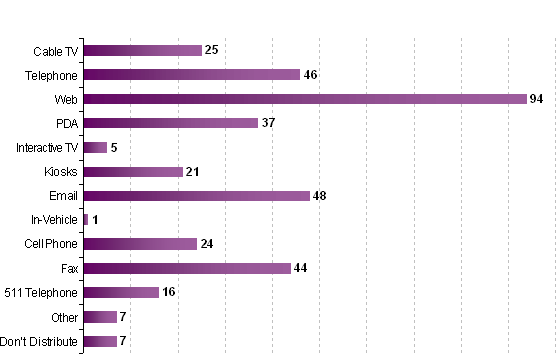
Number of responses - 117
Please check all the types of information that your agency distributes, or will distribute, to the public.
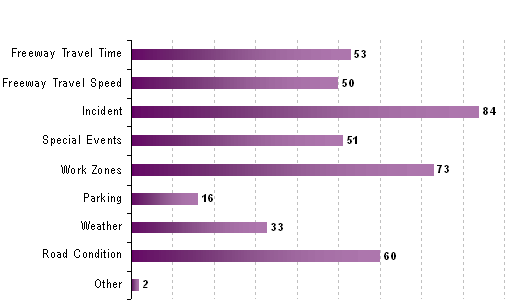
Number of responses - 113
2.3 TMC Incident Management and Disaster Management Programs
TMCs responding to the ITS Deployment Tracking Survey coordinate transportation across multiple jurisdictions, which often include cities, towns, counties and even across state lines. As reported in the 2002 ITS Deployment Tracking Survey, TMCs perform a variety of functions, depicted in Exhibit 4:
| Activity | # of TMCs (from 87) |
% of TMCs (out of 100%) |
|---|---|---|
| Network or roadway surveillance and data collection | 79 | 91 |
| Incident management (e.g., detection, verification and monitoring of incident status) | 86 | 99 |
| Information dissemination (public, private, and interagency) | 82 | 94 |
| En-route driver information (e.g., CMS, HAR) | 73 | 84 |
| Environmental monitoring (e.g., air quality, noise and weather) | 44 | 51 |
| Special event traffic management | 75 | 86 |
| Disaster management and traffic coordination | 64 | 74 |
| Emergency services traffic control coordination | 62 | 71 |
| Ramp management and control | 27 | 31 |
| Lane management and control (e.g., HOV, reversible or freeway lanes) | 29 | 33 |
| Corridor management/traffic signal coordination or control | 29 | 33 |
| Network performance monitoring, evaluation and reporting | 32 | 37 |
| Other | 6 | 7 |
While all of these functions are critical for transportation operations, TMC activities for incident management, disaster management and traffic coordination are of particular relevance to the ETO project. These activities provide a regional foundation for establishing the procedures and technologies necessary to enhance the capabilities and functionality of the transportation system to manage major events resulting from natural disasters, technological accidents, and national security events.
Over the past decade, coordinated traffic incident management efforts have gained momentum as more and more transportation agencies seek ways to safely and efficiently handle congestion. Traffic incident management, once considered a disjointed activity fraught with turf battles and jurisdictional conflicts, has, in some places around the country, become a showcase of collaborative efforts between the various traffic incident management stakeholders. The stakeholders are many – the FHWA and other federal agencies, operations and maintenance personnel from state and local Departments of Transportation, police, fire and emergency services, the towing and recovery industry, transportation planners at the local, regional and state level, and the media – and they all play a role in ensuring that incidents are quickly detected, responded to, and cleared with minimum disruption to traffic flow. All this is done while giving first priority to the safety of the motoring public and the responders.
2.4 ITS Deployment Tracking Survey Results for Incident Management
Relevant findings from the 2002 ITS Deployment Tracking Survey pertaining to the capabilities of the 119 freeway management agencies submitting responses to support incident management and emergency response include the following:
- Statewide Emergency and Traffic Incident Response Planning – The 2002 ITS Deployment Tracking Survey indicates that 80 percent of surveyed agencies (88 agencies) participate in a statewide disaster planning program. Fifty-six agencies (52 percent of responding agencies) participate in a formal multi-agency regional or statewide program to coordinate management of traffic incidents which contains strategic planning (a mutually agreed to statement of multi-agency program goals and measurable objectives), program planning (a multi-year, multi-agency program plan that maps out the process toward meeting program goals and identifying initiatives, tasks and funding sources), and an annual work plan (a plan of tasks, projects, or initiatives for participating agencies to be done during the current year with funding secured). Eighty-one responding agencies (74 percent) participate in a team that meets on a regular basis to evaluate and improve coordinated incident response and to address traffic problems as well.
- Call-out Procedures and Contact Lists – Ninety-eight responding agencies (approximately 92 percent) have formal call-out procedures in place for responding to traffic incidents. Eighty-eight responding agencies (approximately 82 percent) have developed a multi-agency contact list for their regions which contains the names, phone numbers, pager numbers, and other pertinent information for the appropriate response personnel. These results are depicted in Exhibit 5.
Has a multi-agency contact list been developed in your area containing the names, phone numbers, pager numbers, and other pertinent information for the appropriate response personnel?
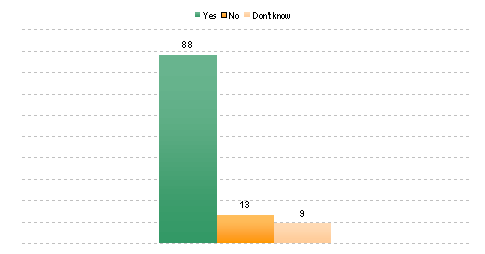
Number of responses - 110
- On-scene Agency-in-Charge – Law enforcement directs traffic on-scene at major traffic incidents and events for 90 agencies (82 percent) that responded to the 2002 ITS Deployment Tracking Survey. In the majority of cases, state law enforcement is the lead agency in charge during a major event which affects the freeway system. Other agencies that may lead the transportation response include local law enforcement and fire and rescue (when there is a hazardous materials event or smoke conditions). Law enforcement and fire and rescue responses to the 2002 ITS Deployment Tracking Survey further indicate that law enforcement is typically the agency in charge of traffic operations during a major incident. More details regarding these findings are presented in Exhibits 6 and 7.
Is there a legal specification by state law or formal agreement as to who is in charge at the scene of a traffic incident (Incident Commander)?
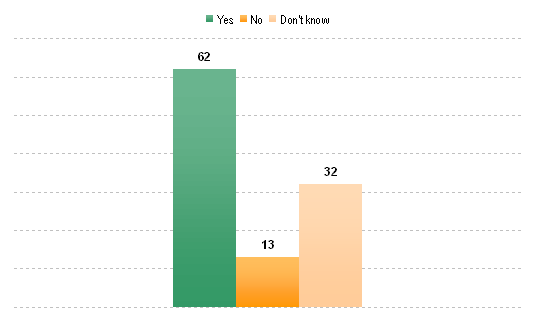
Number of responses - 107
What agency usually directs traffic on scene at major traffic incidents in your area? Please select only one.
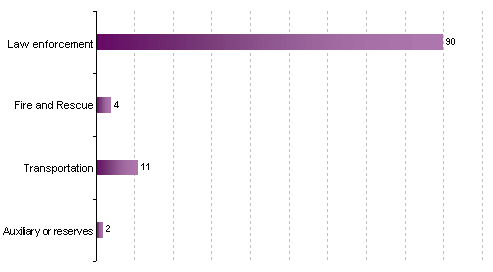
Number of responses - 107
- Use of the Incident Command System (ICS) – Seventy-four agencies (67 percent) use ICS on-scene to manage traffic incidents – 24 of these agencies are required to do so by state law; 50 agencies use ICS through agreement with responding agencies. Thirty-seven agencies (35 percent) have worked within their jurisdictions to develop and adopt a plan for staging and parking response vehicles and equipment at a traffic incident site in a manner that minimizes lane blockage and facilitates the re-opening of lanes. Seventy-six agencies (70 percent) indicated that on-scene responders to traffic incidents are familiar with standards for traffic control specified in the Manual on Uniform Traffic Control Devices (MUTCD).
- Real-time Information Exchange with Law Enforcement and Fire and Rescue Agencies – Thirty-eight transportation agencies reported to the 2002 ITS Deployment Tracking Survey that they exchange real-time information with state law enforcement; 30 agencies exchange real-time information with local law enforcement; and 24 agencies have this capability with fire and rescue agencies. See Exhibit 8.
With what types of agencies does your agency electronically share real-time and/or after-the-fact reporting information on traffic incidents?)
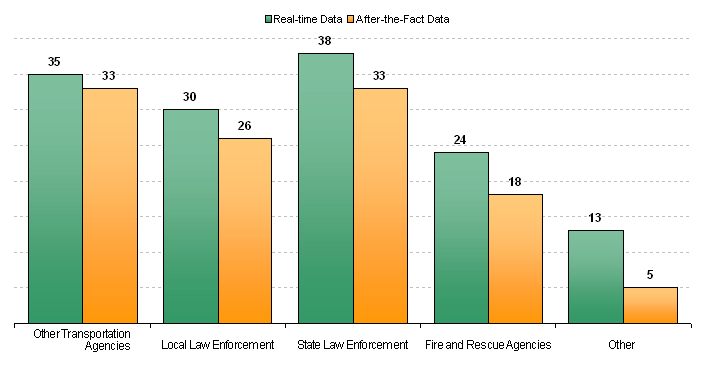
Number of responses - 73
- Special Events – Approximately 65 percent of surveyed agencies participate in a formal multi-agency initiative to proactively plan for and coordinate activities regionally related to special events. Approximately 60 percent of the agencies participating in special events (35 percent of total respondents) support the development of formal plans and procedures to document activities necessary for special events management. The majority of these agencies coordinate their participation through multi-agency teams and interagency agreements.
- Alternate Routes – Approximately 55 percent of respondents have pre-planned alternate routes which can be implemented for sections of the freeway system. As indicated in Exhibit 9, the majority of these respondents have established criteria to direct the implementation of alternate route plans, including incident type and duration, incident location, number of lanes involved in incident, and time of day.
What criteria must be met to implement the alternate route plan? (Check all that apply.)
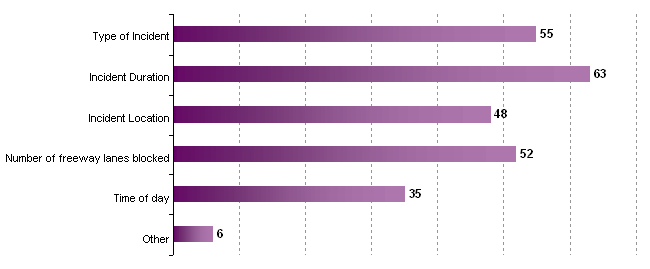
Number of responses - 64
- Agreements for Electronic Connectivity – Thirty-six agencies (30 percent) reported that they have formal agreements in place to establish and/or systematically maintain the ability to share information with other systems or agencies. These agreements have been used to facilitate connection between TMC systems and local E-911 centers and law enforcement Computer-Aided Dispatch (CAD) systems. Exhibit 10 presents details regarding these agreements.
Please indicate the following components of the agreement [for electronic connectivity with another agency]: (check all that apply).
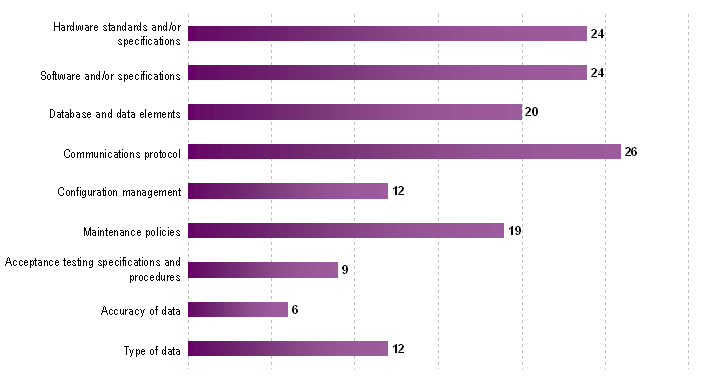
Number of responses - 36
2.5 TMC Assumptions to Direct Development of Information Request
Based on this information, the research team established a set of common assumptions regarding the operational capabilities of TMCs. As explained in the Report Methodology section above, these assumptions were used to guide the development of the additional information request administered to TMCs. These assumptions are listed below:
- The TMC is located in a regional area that experiences high levels of congestion on both freeway and arterial systems.
- The TMC covers the entire freeway system for the region but does not have jurisdiction or coverage on major arterials.
- The state Department of Transportation (DOT) is a central player in the operation and management of the TMC, and the TMC coordinates closely with state DOT districts, divisions, and offices, particularly maintenance and traffic safety. The TMC has multiple systems available for communicating with other state DOT offices, districts and personnel (computer, phone, beeper/pager, digital walkie-talkie, and radio).
- The TMC has limited capability to share computer data and video images with arterial signal control centers and with the regional transit authority. There are "hot lines" between these agencies for communications in emergencies. TMCs work with these agencies on a daily basis and have established personal contacts and formal and/or informal communication protocols with them.
- The TMCs closest working relationship with an emergency response agency is with the state police. Most likely, the TMC is not directly connected to the state police CAD system, but the TMC may be co-located with state police and has established procedures in place for sharing information.
- The freeway management system deployed by the TMC has loop detection capabilities, CCTV surveillance coverage is available on the most heavily traveled freeway sections, and changeable message signs are in place at most major decision points. A ramp metering system may be in place on freeways in the most heavily traveled portions of the region.
- The TMC may be able to provide a limited number of CCTV camera images to the main DOT maintenance center in the region and to state police.
- The TMC has a web site that can display route-specific information on freeways only. Roadway condition information can be displayed on a map. A limited number of camera feeds are available to television stations that have signed up for the service. These feeds may also be displayed on the TMC website.
- Arterial alternate routes are available for most major freeways except for several major bridge crossings.
- Arterial signal control is under multiple jurisdictions. Some corridors have advanced signal control while others do not.
Based on these assumptions, a Rapid Response Information Request for Emergency Transportation Operations was developed and administered to 51 traffic operations agencies, identified by the research team as having a role in supporting emergency operations in their region. The Information Request is located in Appendix A and the complete list of TMC contacts who received the request is located in Appendix B. The majority of these agencies are TMCs for freeway systems, though a few arterial operations were also identified.
The Information Request was developed through several drafts and an on-site pilot administration at Maryland Coordinated Highways Action Response Team (CHART). TMC contacts were identified through a series of telephone calls to locate the person in the traffic operations agency most likely to have the information requested by the research team.
On Friday, September 12, 2003, the Rapid Response Information Request for the Emergency Transportation Operations Project was emailed to the 51 contacts at transportation operations agencies identified by the FHWA and the research team. Given the tight time-frame of the project, traffic operations contacts were given one week in which to complete the request and submit it to the research team. The research team facilitated completion of the request by calling the contacts, answering questions, and administering the information request over the phone.
In total, the research team received 36 completed information requests for a 70% response rate. Considering that the TMC contacts were given only one week's time to complete the request, the research team believes that this level of cooperation and participation indicates a high level of interest in FHWA's project. Responding agencies are identified below.
Responding Agencies:
- Phoenix Traffic Operations Center
- California Department of Transportation District 4 TMC (San Francisco and surrounding counties)
- California Department of Transportation District 11 TMC (San Diego and surrounding counties)
- Miami Regional Transportation Management Center
- Orlando Regional Transportation Mgmt Center
- Georgia Department of Transportation TMC
- City of Atlanta Traffic Control Center
- Illinois Department of Transportation
- Illinois State Toll Highway Authority
- Indianapolis Traffic Management Center
- Maryland CHART
- TRIMARC Kentucky
- Massachusetts Highway Department
- Michigan Department of Transportation
- Oakland County Roadway Commission
- St. Louis TMC
- Nebraska Department of Roads
- Traffic Operations Center – North Jersey
- Traffic Operations Center – South Jersey
- New Jersey Turnpike Authority
- New Mexico Department of Transportation
- New York State Department of Transportation Capital Region TMC
- New York State Department of Transportation – ITS Group
- New York City Department of Transportation
- Charlotte Metrolina Regional TMC
- ARTIMIS Cincinnati Control Center
- Ohio Department of Transportation
- Oregon Department of Transportation
- Pennsylvania Turnpike Commission
- Pittsburg TMC
- TxDOT Austin District
- Salt Lake City Division of Transportation
- Salt Lake County Public Works
- Smart Traffic Center – Northern Virginia
- Washington State Department of Transportation – Northwest Region TMC
- Milwaukee TOC
1. Excerpted from TMC Pooled Fund Study Project, Guidelines for TMC Transportation Management Operations Technician Staff Development, Appendix D: Selection Of The 16 TMC Functions, December 2002, pgs. D-7 to D-10.